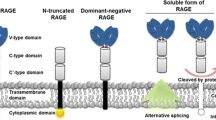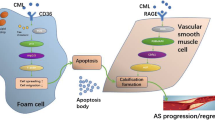Abstract
Cardiovascular disease (CVD) is the leading cause of mortality worldwide. Atherosclerosis constitutes the main pattern of cardiovascular disease and leads to thickening of the intima with plaque formation and eventual occlusion of the arterial lumen. A large amount of evidence links advanced glycation end products (AGEs) with the development or progression of atherosclerosis, regardless of the diabetic status. AGEs are a heterogenous group of compounds formed by the nonenzymatic reaction of reducing sugars with proteins, lipids, and nucleic acids. Although AGEs are formed endogenously in the body, diet has recently been recognized as an important exogenous source. An increased understanding of the mechanisms of formation and interaction of AGEs has allowed the development of several potential anti-AGE approaches.
Similar content being viewed by others
References and Recommended Reading
Murray CJ, Lopez AD: Alternative projections of mortality and disability by cause 1990–2020: Global Burden of Disease Study. Lancet 1997, 349:1498–1504.
Yusuf HR, Giles WH, Croft JB, et al.: Impact of multiple risk factor profiles on determining cardiovascular disease risk. Prev Med 1998, 27:1–9.
Baynes JW, Thorpe SR: Glycoxidation and lipoxidation in atherogenesis. Free Radic Biol Med 2000, 28:1708–1716.
Nerlich AG, Schleicher ED: N ∈-(carboxymethyl)lysine in atherosclerotic vascular lesions as a marker for local oxidative stress. Atherosclerosis 1999, 144:41–47.
Sims TJ, Rasmussen LM, Oxlund H, Bailey AJ: The role of glycation cross-links in diabetic vascular stiffening. Diabetologia 1996, 39:946–951.
Stitt AW, He C, Friedman S, et al.: Elevated AGE-modified apoB in sera of euglycemic, normolipidemic patients with atherosclerosis: relation to tissue AGE. Mol Med 1997, 3:617–627.
Vlassara H, Palace MR: Diabetes and advanced glycation end products. J Intern Med 2002, 251:87–101.
Fu MX, Requena JR, Jenkins AJ, et al.: The advanced glycation end product, N_-(carboxymethyl)lysine, is a product of both lipid peroxidation and glycoxidation reactions. J Biol Chem 1996, 271:9982–9986.
Nicholl ID, Bucala R: Advanced glycation end products and cigarette smoking. Cell Mol Biol (Noisy-le-grand) 1998, 44:1025–1033.
Lee T, Kimiagar M, Pintauro SJ, Chichester CO: Physiological and safety aspects of Maillard browning of foods. Prog Food Nutr Sci 1981, 5:243–256.
Koschinsky T, He CJ, Mitsuhashi T, et al.: Orally absorbed reactive advanced glycation end products (glycotoxins): an environmental risk factor in diabetic nephropathy. Proc Natl Acad Sci U S A 1997, 94:6474–6479.
He C, Sabol J, Mitsuhashi T, Vlassara H: Dietary glycotoxins: inhibition of reactive products by aminoguanidine facilitates renal clearance and reduces tissue sequestration. Diabetes 1999, 48:1308–1315.
Cai W, Cao Q, Zhu L, et al.: Oxidative stress-inducing carbonyl compounds from common foods: novel mediators of cellular dysfunction. Mol Med 2002, 8:337–346.
Zheng F, He C, Cai W, et al.: Prevention of diabetic nephropathy in mice by a diet low in glycoxidation products. Diabetes Metab Res Rev 2002, 18:224–237.
Peppa M, Brem H, Ehrlich P, et al.: Adverse effects of dietary glycotoxins on wound healing in genetically diabetic mice. Diabetes 2003, 52:2805–2813.
Lin RY, Reis ED, Dore AT, et al.: Lowering of dietary advanced glycation end products (AGE) reduces neointimal formation after arterial injury in genetically hypercholesterolemic mice. Atherosclerosis 2002, 163:303–311.
Lin RY, Choudhury RP, Cai W, et al.: Dietary glycotoxins promote diabetic atherosclerosis in apolipoprotein E-deficient mice. Atherosclerosis 2003, 168:213–220.
Sebekova K, Faist V, Hofmann T, et al.: Effects of a diet rich in advanced glycation end products in the rat remnant kidney model. Am J Kidney Dis 2003, 41(3 suppl 1):S48-S51.
Peppa M, HE C, Hattori M, et al.: Fetal or neonatal lowglycotoxin environment prevents autoimmune diabetes in NOD mice. Diabetes 2003, 52:1441–1448.
Hofmann SM, Dong HJ, Li Z, et al.: Improved insulin sensitivity is associated with restricted intake of dietary glycoxidation products in the db/db mouse. Diabetes 2002, 51:2082–2089.
Vlassara H, Cai W, Crandall J, et al.: Inflammatory mediators are induced by dietary glycotoxins, a major risk factor for diabetic angiopathy. Proc Natl Acad Sci U S A 2002, 99:15596–15601. Shows for the first time that a diet low in AGE content diminishes the serum AGE levels, as well as levels of circulating markers of inflammation and endothelial dysfunction, in humans. This raises the therapeutic possibility of using dietary intervention to diminish the body AGE burden.
Uribarri J, Peppa M, Cai W, et al.: Dietary glycotoxins correlate with circulating advanced glycation end product levels in renal failure patients. Am J Kid Dis 2003, 42:532–538. Demonstrates for the first time a significant correlation between dietary content of AGEs and serum levels of AGEs, providing support to the postulation that dietary AGEs are important contributors to the body AGE burden.
Uribarri J, Peppa M, Cai W, et al.: Restriction of dietary glycotoxins markedly reduces AGE toxins in renal failure patients. J Am Soc Nephrol 2003, 14:728–731.
Gugliucci A, Bendayan M: Renal fate or circulating advanced glycated end products (AGE): evidence for reabsorption and catabolism of AGE-peptides by renal proximal tubular cells. Diabetologia 1996, 39:140–160.
Makita Z, Radoff S, Rayfield EJ, et al.: Advanced glycosylation end products in patients with diabetic nephropathy. N Engl J Med 1991, 325:836–842.
Shinohara M, Thornalley PJ, Giardino I, et al.: Overexpression of glyoxalase-I in bovine endothelial cells inhibits intracellular advanced glycation end product formation and prevents hyperglycemia-induced increases in macromolecular endocytosis. J Clin Invest 1998, 101:1142–1147.
Vlassara H: The AGE-receptor in the pathogenesis of diabetic complications. Diabetes Metab Res Rev 2001, 17:436–443.
Sakurai S, Yonekura H, Yamamoto Y, et al.: The AGE-RAGE system and diabetic nephropathy. J Am Soc Nephrol 2003, 14:S259-S263.
Zheng F, Cai W, Mitsuhashi T, Vlassara H: Lysozyme enhances renal excretion of advanced glycation end products in vivo and suppresses adverse age-mediated cellular effects in vitro: a potential AGE sequestration therapy for diabetic nephropathy? Mol Med 2001, 7:737–747.
Bucala R, Tracey KJ, Cerami A: Advanced glycosylation products quench nitric oxide and mediate defective endothelium-dependent vasodilatation in experimental diabetes. J Clin Invest 1991, 87:432–438.
Rumble JR, Cooper ME, Soulis T, et al.: Vascular hypertrophy in experimental diabetes: role of advanced glycation end products. J Clin Invest 1997, 99:1016–1027.
Bucala R, Mitchell R, Arnold K, et al.: Identification of the major site of apolipoprotein B modification by advanced glycosylation end products blocking uptake by the low density lipoprotein receptor. J Biol Chem 1995, 270:10828–10832.
Zhang J, Ren S, Sun D, Shen GX: Influence of glycation on LDL-induced generation of fibrinolytic regulators in vascular endothelial cells. Arterioscler Thromb Vasc Biol 1998, 18:1140–1148.
Hedrick CC, Thorpe SR, Fu MX, et al.: Glycation impairs high-density lipoprotein function. Diabetologia 2000, 43:312–320.
Zhang J, Ren S, Shen GX: Glycation amplifies lipoprotein(a)-induced alterations in the generation of fibrinolytic regulators from human vascular endothelial cells. Atherosclerosis 2000, 150:299–308.
Lassegue B, Clempus RE: Vascular NAD(P)H oxidases: specific features, expression, and regulation. Am J Physiol Regul Integr Comp Physiol 2003, 285:R277-R297.
Panagiotopoulos S, O'Brien RC, Bucala R, et al.: Aminoguanidine has an anti-atherogenic effect in the cholesterol-fed rabbit. Atherosclerosis 1998, 136:125–131.
Palinski W, Koschinsky T, Butler SW, et al.: Immunological evidence for the presence of advanced glycation end products in atherosclerotic lesions of euglycemic rabbits. Arterioscler Thromb Vasc Biol 1995, 15:571–582.
Vlassara H, Fuh H, Donnelly T, Cybulsky M: Advanced glycation end products promote adhesion molecule (VCAM-1, ICAM-1) expression and atheroma formation in normal rabbits. Mol Med 1995, 1:447–456.
Vlassara H, Fuh H, Makita Z, et al.: Exogenous advanced glycosylation end products induce complex vascular dysfunction in normal animals: a model for diabetic and aging complications. Proc Natl Acad Sci U S A 1992, 89:12043–12047.
Wautier JL, Zoukourian C, Chappey O, et al.: Receptor-mediated endothelial cell dysfunction in diabetic vasculopathy. Soluble receptor for advanced glycation end products blocks hyperpermeability in diabetic rats. J Clin Invest 1996, 97:238–243.
Crauwels HM, Herman AG, Bult H: Local application of advanced glycation end products and intimal hyperplasia in the rabbit collared carotid artery. Cardiovasc Res 2000, 40:173–182.
Brownlee M, Vlassara H, Kooney A, et al.: Aminoguanidine prevents diabetes-induced arterial wall protein crosslinking. Science 1986, 232:1629–1632.
Miyata T, Ishikawa S, Asahi K, et al.: 2-Isopropylidenehydrazono-4-oxo-thiazolidin-5-ylacetanilide (OPB-9195) treatment inhibits the development of intimal thickening after balloon injury of rat carotid artery: role of glycoxidation and lipoxidation reactions in vascular tissue damage. FEBS Lett 1999, 445:202–206.
Park I, Raman KG, Lee KJ, et al.: Suppression of accelerated diabetic atherosclerosis by the soluble receptor for advanced glycation end products. Nat Med 1998, 4:1025–1031.
Wolffenbuttel BH, Boulanger CM, Crijns FR, et al.: Breakers of advanced glycation end products restore large artery properties in experimental diabetes. Proc Natl Acad Sci U S A 1998, 95:4630–4634.
Vaitkevicius PV, Lane M, Spurgeon H, et al.: A cross-link breaker has sustained effects on arterial and ventricular properties in older rhesus monkeys. Proc Natl Acad Sci U S A 2001, 98:1171–1175.
Vasan S, Foiles PG, Founds HW: Therapeutic potential of AGE inhibitors and breakers of AGE protein cross-links. Expert Opin Investig Drugs 2001, 10:1977–1987.
Nakamura Y, Horii Y, Nishino T, et al.: Immunohistochemical localization of advanced glycosylation end products in coronary atheroma and cardiac tissue in diabetes mellitus. Am J Pathol 1993, 143:1649–1656.
Schleicher ED, Wagner E, Nerlich AG: Increased accumulation of the glycoxidation product N(epsilon)-(carboxymethyl) lysine in human tissues in diabetes and aging. J Clin Invest 1997, 99:457–468.
Yamada K, Miyahara Y, Hamaguchi K, et al.: Immunohistochemical study of human advanced glycation end-products in chronic renal failure. Clin Nephrol 1994, 42:354–361.
Tan KC, Chow WS, Ai VH, et al.: Advanced glycation end products and endothelial dysfunction in type 2 diabetes. Diabetes Care 2002, 25:1055–1059.
Kass DA, Sapiro EP, Kawaguchi M, et al.: Improved arterial compliance by a novel advanced glycation end-product crosslink breaker. Circulation 2001, 104:1464–1470. The first time that a drug is shown to increase arterial distensibility in humans; this work opens the possibility of the use of AGE breakers to directly modify vascular disease.
Stirban A, Sander D, Buenting C, et al.: Food advanced glycation end products (AGE) acutely impair endothelial function in patients wit diabetes mellitus [abstract]. Diabetes 2003, 52(suppl 1):A19.
Nangaku M, Miyata T, Sada T, et al.: Anti-hypertensive agents inhibit in vivo the formation of advanced glycation end products and improve renal damage in a type 2 diabetic nephropathy rat model. J Am Soc Nephrol 2003, 14:1212–1222.
Author information
Authors and Affiliations
Rights and permissions
About this article
Cite this article
Peppa, M., Uribarri, J. & Vlassara, H. The role of advanced glycation end products in the development of atherosclerosis. Curr Diab Rep 4, 31–36 (2004). https://doi.org/10.1007/s11892-004-0008-6
Issue Date:
DOI: https://doi.org/10.1007/s11892-004-0008-6




